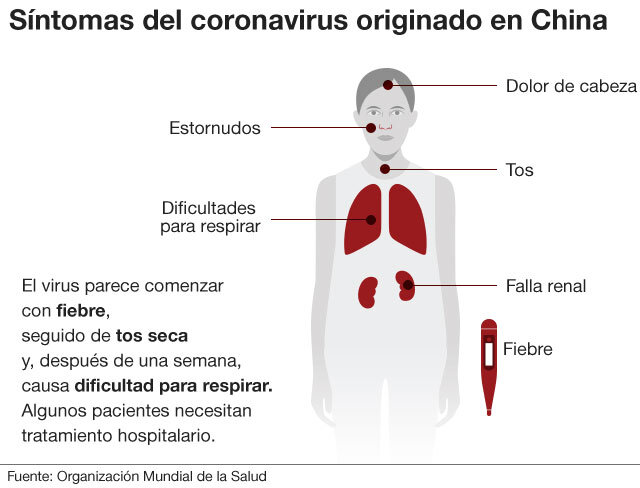Naciones Unidas liberan $15 millones para ayudar a los países vulnerables a combatir la propagación del coronavirus
/⇣ English translation provided at the end ⇣
Redacción
LA PRENSA
Los últimos números: el nuevo coronavirus ha matado a más de 3.100 personas, la gran mayoría en China continental. Hay más de 90.000 casos globales, con infecciones en más de 70 países y territorios.
Según un comunicado de prensa publicado en la página de la Organización de Mundial de la Salud (OMS), el jefe de la oficina de las Naciones Unidas de Asuntos Humanitarios, Mark Lowcock, liberó $15 millones del Fondo Central para la Acción en Casos de Emergencia (CERF) para ayudar a financiar los esfuerzos mundiales para contener el virus responsable de la COVID-19.
El anuncio se produjo cuando la OMS elevó el riesgo mundial del brote de coronavirus a «muy alto», su nivel máximo de evaluación de riesgos. La OMS ha dicho que todavía hay una posibilidad de contener el virus si se corta su cadena de transmisión.
El repentino aumento de los casos registrados en Italia, la República Islámica del Irán y la República de Corea es muy preocupante. Actualmente hay casos relacionados con la República Islámica de Irán en Bahrein, el Iraq, Kuwait y Omán, así como casos relacionados con Italia en Alemania, Argelia, Austria, Croacia, España y Suiza.
Los fondos de las Naciones Unidas se han entregado a la OMS y al Fondo de las Naciones Unidas para la Infancia (UNICEF). Servirán para financiar actividades esenciales como la vigilancia de la propagación del virus, la investigación de los casos y el funcionamiento de los laboratorios nacionales.
La OMS ha hecho un llamamiento para recaudar $675 millones con el fin de financiar la lucha contra el coronavirus. Existe una oportunidad de contener la propagación del virus si los países adoptan medidas enérgicas para detectar los casos a tiempo, aislar y atender a los pacientes y localizar a los contactos.
Corea del Sur: 600 nuevas infecciones impulsaron el total del país del este asiático a más de 4.800, incluidas 29 muertes, el mayor brote fuera de China continental.
El Coordinador del Socorro de Emergencia y Secretario General Adjunto de Asuntos Humanitarios, Mark Lowcock, dijo: “Sigue sin haber pruebas de que el virus se esté propagando sin control. Mientras esta sea la situación, todavía tenemos una oportunidad de contenerlo.”
“Sin embargo, hay que adoptar medidas rápidas y enérgicas para detectar los casos a tiempo, aislar y atender a los pacientes, y localizar a los contactos. Debemos actuar ahora para evitar que este virus ponga en riesgo más vidas.”
“Esta donación del fondo para emergencias de las Naciones Unidas ayudará a los países con sistemas de salud frágiles a fortalecer sus operaciones de detección y respuesta. Podría salvar las vidas de millones de personas en situación vulnerable.”
Este es un punto crítico en la evolución del brote. Los esfuerzos deben concentrarse en contener la COVID-19 mediante el fortalecimiento de la vigilancia, la realización de investigaciones exhaustivas para localizar los contactos y la aplicación de medidas adecuadas para evitar que se siga propagando.
Tedros Adhanom Ghebreyesus, director general de la OMS dijo, “La posibilidad de que el virus se propague a países con sistemas de salud más endebles es una de nuestras mayores preocupaciones. Estos fondos ayudarán a que estos países puedan prepararse para detectar y aislar los casos, proteger a sus trabajadores sanitarios y proporcionar a los pacientes una atención digna y adecuada. Esto nos ayudará a salvar vidas y a hacer retroceder el virus.”
Estados Unidos: ahora hay más de 100 infecciones en Estados Unidos, y Washington y California son los estados más afectados. Seis pacientes han muerto.
La UNICEF está impulsando la adopción de medidas preventivas a nivel comunitario en los países afectados a través de actividades de comunicación de riesgos, así como mediante el suministro de botiquines médicos y kits de higiene a escuelas y clínicas de salud, y el seguimiento de los efectos del brote para apoyar el mantenimiento de los servicios asistenciales, educativos y sociales.
“En este momento crucial, hay que hacer todos los esfuerzos posibles para hacer retroceder el brote”, dijo Henrietta Fore, directora ejecutiva de UNICEF “Estos fondos indispensables servirán para apoyar los esfuerzos que estamos llevando a cabo en todo el mundo para reforzar los sistemas de salud más frágiles e informar a los niños, las mujeres embarazadas y las familias sobre cómo protegerse.”
OMS en alerta: el director general de la Organización Mundial de la Salud advirtió que el virus ha llevado al mundo a un "territorio desconocido".
El llamado oficialmente covid-19 mantiene en alerta a las organizaciones sanitarias alrededor del mundo pues su propagación y capacidad de contagio parece ser más intensa de lo que originalmente advirtieron en China.
Este coronavirus es una nueva cepa que no se había visto antes en humanos, lo que significa que aún queda mucho por investigar al respecto.
Pero ¿cómo se transmite, cuáles son los síntomas, cómo prevenir su contagio y qué tan mortal es realmente?
¿Dónde se originó el coronavirus?
Los primeros casos humanos de covid-19 se identificaron en Wuhan en diciembre de 2019.
Aunque China no ha podido confirmar la fuente exacta del virus, las autoridades sospechan que el brote se originó en un mercado de esta ciudad en el que se realizaban “transacciones ilegales de animales salvajes” y que el virus se transmitió originalmente de un animal a un humano.
"Se trata de uno de los llamados 'mercados mojados' que son muy comunes en Asia", explica Howard Zhang, editor del servicio chino de la BBC. "Son mercados en los que se venden animales vivos".
Por qué hay tanta urgencia por encontrar el origen animal del coronavirus
"La gente quiere tener productos frescos. Entonces, por ejemplo, compran un pollo y el vendedor lo sacrifica y lo despedaza allí en el puesto, y todos los desperdicios quedan esparcidos, con poca higiene y salubridad, lo que facilita la propagación de enfermedades", señala Zhang.
Un amplio rango de animales puede haber servido de "huésped" del virus, especialmente el murciélago, conocido por portar un número considerable de distintos coronavirus. De los excrementos de los murciélagos el virus puede haber pasado a los pangolines, cuya piel se usa para fines medicinales en China.
Pero todavía no se sabe exactamente qué animal lo transmitió a las personas
Aunque el virus pudo haber empezado a contagiarse en un mercado, es el flujo de gente que entra y sale de Wuhan lo que desencadenó su rápida propagación.
Wuhan es la séptima ciudad más grande de China y la número 42 del mundo.
El lugar es hogar de 11 millones de personas y es una de las metrópolis más conectadas de China.
La urbe cuenta con un aeropuerto que la conecta con todas las regiones del mundo, de manera directa o indirecta.
Es decir, el virus se propagó así porque mucha gente entra y sale de Wuhan llevando consigo la cepa.
Cómo se transmite. Puede convertirse en una pandemia
Todavía no se sabe cómo o cuándo el virus se volvió infeccioso para las personas. Pero sí se sabe que el virus se transmite de persona a persona.
Según los científicos, cada persona infectada puede transmitir el virus a entre 1,4 y 2,5 personas, desde antes que los síntomas aparezcan.
Coronavirus: ¿cuál es la diferencia entre pandemia, epidemia y una infección endémica?
Esto preocupa a los médicos, pues los virus que infectan los pulmones, como este, son muy efectivos en su propagación debido a la tos y los estornudos y a las secreciones que estos expulsan.
La Organización Mundial de la Salud (OMS) recomienda mantenerse a más de 1 metro de distancia de una persona enferma.
Si estas secreciones caen en algún objeto o superficie, cualquier persona puede contagiarse al entrar en contacto con ellas y después tocarse los ojos, la nariz o la boca, de acuerdo a la OMS.
Esta organización, que sigue investigando las formas de transmisión, pidió el lunes hacer todo lo posible para prepararse "para una potencial pandemia", debido a que el número de enfermos que no están claramente vinculados a China sigue ascendiendo.
Se considera pandemia cuando una enfermedad infecciosa se contagia de persona a persona en varias partes del mundo.
Cuáles son los síntomas y los efectos del coronavirus en el cuerpo
Los coronavirus son una familia amplia de virus, pero se sabe que solo seis (el nuevo sería el séptimo) infectan a las personas.
Los pacientes contagiados con este coronavirus experimentan diversos síntomas, entre ellos, dificultad para respirar, fiebre, tos y dolor muscular.
De acuerdo con las autoridades, el período de incubación del covid-19 (es decir, cuánto tardan los síntomas en aparecer después de contraer la infección) es de entre 1 a 14 días.
El virus puede causar neumonía; es decir, inflamar los pulmones y llenar de agua los alveolos, los pequeños sacos donde el oxígeno pasa del aire a la sangre.
También puede causar dificultad respiratoria aguda que impida a los pulmones proporcionar suficiente oxígeno a los órganos para mantener vivo el cuerpo.
¿A quiénes afecta?
Según un informe publicado en la revista de la Asociación Médica Estadounidense (JAMA, por sus siglas en inglés), la edad media de los pacientes en el actual brote es de entre 49 y 56 años.
Los casos de niños son raros, dice el estudio.
Algunas razones posibles son que hayan estado menos expuestos al virus, o que el cuerpo de los niños responda de manera diferente al virus.
De acuerdo a Mark Denison, especialista en enfermedades infecciosas pediátricas de la Escuela de Medicina de la Universidad de Vanderbilt, EE.UU., es posible que los niños sean sencillamente menos susceptibles que los adultos al nuevo coronavirus debido a que sus células son menos hospitalarias con el patógeno.
Por otro lado, es frecuente que los síntomas causados por los virus sean más leves en los niños que en los adultos.
Un estudio de fines de febrero del Centro Chino para el Control y la Prevención de Enfermedades (CCDC) mostró que el 51% de los pacientes confirmados eran hombres y que la tasa de mortalidad era de 2,8% en los hombres frente al 1,7% de las mujeres.
Parte de la conclusión de los doctores es que "es más probable que [el coronavirus] afecte a los hombres mayores que ya tenían alguna otra enfermedad".
Otro estudio publicado en la revista médica británica Lancet sobre los datos de 99 pacientes infectados con el virus reveló que la edad media era de 55,5 años y que había infectados tres veces más hombres que mujeres.
De acuerdo con los consejos de la OMS, para prevenir el contagio se debe evitar el contacto cercano con personas que sufren infecciones respiratorias agudas.
Además, las personas deben lavarse las manos con frecuencia, especialmente después del contacto directo con personas enfermas o su entorno, y evitar el contacto sin protección con animales de granja o salvajes.
Por otra parte, quienes presenten infecciones respiratorias agudas, deben mantener la distancia con el resto de la gente, cubrirse la boca al toser y estornudar con pañuelos desechables o ropa, y lavarse las manos.
¿El coronavirus es mortal? ¿qué tan letal es?
Hasta este jueves, ha habido más de 82.000 casos confirmados de contagio del covid-19 con más de 2.800 muertes, según la OMS.
Esto significa que la gran mayoría de los pacientes que sufren del virus no mueren.
"Las personas mayores y aquellas con afecciones médicas preexistentes (como presión arterial alta, problemas cardíacos o diabetes) parecen ser más vulnerables", dice la OMS.
La tasa de mortalidad general, de acuerdo con el estudio más completo sobre el brote realizado por el Centro Chino para el Control y la Prevención de Enfermedades (CCDC), es de un 2,3%, siendo las personas mayores de 80 años las que corren más riesgo, con un índice de mortandad del 14,8%.
La investigación del CCDC asegura que alrededor del 80,9% de las infecciones del nuevo coronavirus se clasifican como leves, el 13,8% como graves y solo el 4,7% como críticas, lo que incluye insuficiencia respiratoria y multiorgánica, y shock séptico.
Google Translation
United Nations releases $15 million to help vulnerable countries fight the spread of coronavirus
LA PRENSA
The latest numbers: the new coronavirus has killed more than 3,100 people, the vast majority in mainland China. There are more than 90,000 global cases, with infections in more than 70 countries and territories.
According to a press release published on the page of the World Health Organization (WHO), the head of the United Nations Office for Humanitarian Affairs, Mark Lowcock, released $ 15 million from the Central Fund for Emergency Action (CERF) to help fund global efforts to contain the virus responsible for COVID-19.
The announcement came when WHO raised the global risk of the coronavirus outbreak to "very high", its maximum level of risk assessment. The WHO has said that there is still a possibility of containing the virus if its transmission chain is cut.
The sudden increase in cases registered in Italy, the Islamic Republic of Iran and the Republic of Korea is very worrying. There are currently cases related to the Islamic Republic of Iran in Bahrain, Iraq, Kuwait and Oman, as well as cases related to Italy in Germany, Algeria, Austria, Croatia, Spain and Switzerland.
The United Nations funds have been given to WHO and the United Nations Children's Fund (UNICEF). They will be used to finance essential activities such as the surveillance of the spread of the virus, the investigation of cases and the operation of national laboratories.
WHO has called for $ 675 million to fund the fight against the coronavirus. There is an opportunity to contain the spread of the virus if countries take strong measures to detect cases in time, isolate and care for patients and locate contacts.
South Korea: 600 new infections drove the East Asian country to more than 4,800, including 29 deaths, the largest outbreak in mainland China.
The Emergency Relief Coordinator and Under-Secretary-General for Humanitarian Affairs, Mark Lowcock, said: “There is still no evidence that the virus is spreading out of control. While this is the situation, we still have an opportunity to contain it. ”
“However, we must take swift and energetic measures to detect cases in time, isolate and treat patients, and locate contacts. We must act now to prevent this virus from putting more lives at risk. ”
“This donation from the United Nations emergency fund will help countries with fragile health systems to strengthen their detection and response operations. It could save the lives of millions of people in vulnerable situations. ”
This is a critical point in the evolution of the outbreak. Efforts should focus on containing COVID-19 by strengthening surveillance, conducting thorough investigations to locate contacts and applying appropriate measures to prevent further spread.
Tedros Adhanom Ghebreyesus, director general of the WHO said, “The possibility of the virus spreading to countries with weaker health systems is one of our biggest concerns. These funds will help these countries to prepare to detect and isolate cases, protect their health workers and provide patients with decent and adequate care. This will help us save lives and drive the virus back. ”
United States: there are now more than 100 infections in the United States, and Washington and California are the most affected states. Six patients have died.
UNICEF is promoting the adoption of preventive measures at the community level in the affected countries through risk communication activities, as well as by providing medical kits and hygiene kits to schools and health clinics, and monitoring the effects of the outbreak to support the maintenance of welfare, educational and social services.
"At this crucial moment, every effort must be made to reverse the outbreak," said Henrietta Fore, UNICEF's executive director. "These indispensable funds will support the efforts we are making throughout the world to strengthen systems. health problems and inform children, pregnant women and families about how to protect themselves. ”
WHO on alert: the director general of the World Health Organization warned that the virus has taken the world to an "unknown territory."
The officially called covid-19 keeps health organizations around the world on alert as their spread and ability to spread seems to be more intense than originally warned in China.
This coronavirus is a new strain that had not been seen before in humans, which means that much remains to be investigated.
But how is it transmitted, what are the symptoms, how to prevent its spread and how deadly is it really?
Where did the coronavirus originate?
The first human cases of covid-19 were identified in Wuhan in December 2019.
Although China has not been able to confirm the exact source of the virus, the authorities suspect that the outbreak originated in a market in this city in which "illegal transactions of wild animals" were carried out and that the virus was originally transmitted from an animal to a human.
"This is one of the so-called 'wet markets' that are very common in Asia," explains Howard Zhang, editor of the BBC's Chinese service. "They are markets where live animals are sold."
Why is there such urgency to find the animal origin of the coronavirus
"People want to have fresh produce. So, for example, they buy a chicken and the vendor sacrifices it and rips it up there at the stand, and all the waste is scattered, with poor hygiene and health, which facilitates the spread of disease." , Zhang points out.
A wide range of animals may have served as a "host" for the virus, especially the bat, known to carry a considerable number of different coronaviruses. From the droppings of bats the virus may have passed to pangolins, whose skin is used for medicinal purposes in China.
But it is not yet known exactly which animal transmitted it to people
Although the virus may have begun to spread in a market, it is the flow of people entering and leaving Wuhan that triggered its rapid spread.
Wuhan is the seventh largest city in China and number 42 in the world.
The place is home to 11 million people and is one of the most connected metropolis in China.
The city has an airport that connects it with all regions of the world, directly or indirectly.
That is, the virus spread like this because many people enter and leave Wuhan carrying the strain.
How it is transmitted. It can become a pandemic
It is not yet known how or when the virus became infectious to people. But it is known that the virus is transmitted from person to person.
According to scientists, each infected person can transmit the virus to between 1.4 and 2.5 people, from before the symptoms appear.
Coronavirus: what is the difference between pandemic, epidemic and an endemic infection?
This worries doctors, as viruses that infect the lungs, like this one, are very effective in spreading due to coughing and sneezing and the secretions they expel.
The World Health Organization (WHO) recommends staying more than 1 meter away from a sick person.
If these secretions fall on any object or surface, anyone can become infected by coming into contact with them and then touching their eyes, nose or mouth, according to the WHO.
This organization, which is still investigating the forms of transmission, asked on Monday to do everything possible to prepare "for a potential pandemic," because the number of patients who are not clearly linked to China continues to rise.
It is considered a pandemic when an infectious disease is spread from person to person in various parts of the world.
What are the symptoms and effects of coronavirus in the body
Coronaviruses are a broad family of viruses, but it is known that only six (the new one would be the seventh) infect people.
Patients infected with this coronavirus experience various symptoms, including shortness of breath, fever, cough and muscle pain.
According to the authorities, the incubation period of covid-19 (that is, how long it takes for symptoms to appear after contracting the infection) is between 1 to 14 days.
The virus can cause pneumonia; that is, inflame the lungs and fill the alveoli with water, the small sacs where oxygen passes from the air to the blood.
It can also cause acute respiratory distress that prevents the lungs from providing enough oxygen to the organs to keep the body alive.
Who does it affect?
According to a report published in the Journal of the American Medical Association (JAMA), the average age of patients in the current outbreak is between 49 and 56 years.
Cases of children are rare, says the study.
Some possible reasons are that they have been less exposed to the virus, or that the children's body responds differently to the virus.
According to Mark Denison, a pediatric infectious disease specialist at the Vanderbilt University School of Medicine, USA, children may simply be less susceptible than adults to the new coronavirus because their cells are less hospitable With the pathogen.
On the other hand, the symptoms caused by viruses are often milder in children than in adults.
A late February study by the Chinese Center for Disease Control and Prevention (CCDC) showed that 51% of confirmed patients were men and that the mortality rate was 2.8% in men versus 1, 7% of women.
Part of the doctors' conclusion is that "it is more likely that [the coronavirus] affects older men who already had some other disease."
Another study published in the British medical journal Lancet on data from 99 patients infected with the virus revealed that the average age was 55.5 years and that they had infected three times more men than women.
According to the advice of the WHO, to prevent contagion, close contact with people suffering from acute respiratory infections should be avoided.
In addition, people should wash their hands frequently, especially after direct contact with sick people or their surroundings, and avoid unprotected contact with farm or wild animals.
On the other hand, those with acute respiratory infections should keep their distance with the rest of the people, cover their mouths when coughing and sneeze with tissues or clothes, and wash their hands.
Is the coronavirus deadly? How lethal is it?
As of Thursday, there have been more than 82,000 confirmed cases of contagion of covid-19 with more than 2,800 deaths, according to the WHO.
This means that the vast majority of patients suffering from the virus do not die.
"Older people and those with pre-existing medical conditions (such as high blood pressure, heart problems or diabetes) seem to be more vulnerable," says WHO.
The general mortality rate, according to the most complete study on the outbreak carried out by the Chinese Center for Disease Control and Prevention (CCDC), is 2.3%, with people over 80 years of age They are at greater risk, with a death rate of 14.8%.
CCDC research ensures that about 80.9% of new coronavirus infections are classified as mild, 13.8% as severe, and only 4.7% as critical, including respiratory and multiorgan failure, and shock septic.









































